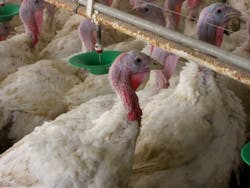About the author: Susan Watkins, Ph.D., is emeritus professor for the University of Arkansas Div. of Agriculture Cooperative Extension Service. Watkins can be reached at [email protected].
Now more than ever, drinking water quality plays an important role in the healthy production of broiler chickens, hatching eggs, turkeys and table eggs. With more than 25,000 poultry farms in the U.S. and more on the way, the need for reputable and cost-effective assistance with identifying and correcting poultry farm drinking water challenges is at an all-time high.
Dictated by the need to continuously improve sustainability, poultry genetic companies have answered the call by steadily selecting efficient genetic traits. As a trade-off, this can result in birds that are more vulnerable to stressors as compared to their ancestors. This is why what worked 20 years ago on a poultry farm may no longer be applicable today. Secondly, the trend to grow flocks without antibiotics further stresses the need to assure all inputs are ideal to minimize health risks that were once easily prevented with medications.
To avoid production disruptions, poultry should have enough quality water to help soften feed and optimize digestion.
Staying Hydrated
Water is the number one input into poultry production, primarily because birds have little saliva, so they require nearly twice as much water to help soften feed and optimize digestion. Skimping on quality or quantity can lead to costly production mistakes.
Poultry operation water management should be different from residential and most commercial applications. After water leaves the source, it could be subjected to varying levels of flow over time, may pass through storage, may be warmed, and/or have products such as vitamins, organic acids or probiotics added. Each of these factors creates a risk for microbial contamination.
Water sanitation is a necessity, and because recontamination can occur within the system, a sanitizer that provides residual all the way to the birds is ideal. Sampling water both at the source and where the birds are consuming it can provide solid data on whether a sanitizer is working effectively. Installing systems that poultry farmers can easily manage and monitor also will help ensure success. In addition, implementing a cleaning program will help farmers maximize the cleanliness of their water systems when no birds are present and further assure that a daily water sanitation program during flocks is effective and affordable.
Swabbing the inside of the water line can help determine the amount of bacteria present in the biofilm.
Controlling Contaminants
The poultry industry has mostly adopted the U.S. EPA standards for maximum contaminant levels of minerals, but often for different reasons. Controlling calcium and magnesium is important to prevent scale issues that can reduce pipe volume over time and limit quantity. These minerals also are damaging to cool cell pads, causing reduced air flow and limiting the ability to cool flocks during hot weather. Minerals such as iron, manganese or sulfur are well-tolerated by the birds, but unfortunately they also are the key food for many pathogens such as E. coli and pseudomonas.
Oxidation and filtration work well to improve the performance of hundreds of poultry operations where these contaminants are present. The modern bird also has limited tolerance for sodium and chloride in the water with as little as 200 ppm of either or both, causing diarrhea and reduced performance. It can be difficult to convince poultry farmers to spend the money on reverse osmosis, but it can make a dramatic difference.
When working with poultry farmers, listen for clues of what challenges they may be facing in their operation. Health issues, such as high initial mortality or recurring disease challenges, point toward microbial contamination that needs to be addressed with an effective sanitation program. If the clues point towards poor weight gains and feed conversions, or reduced egg output from the egg layers but birds look and act healthly, then start looking for restriction points that limit water usage. Cheap hose fittings on injectors or undersized injectors (gal-per-minute output) can limit water usage during crucial consumption periods and train flocks to drink less because they cannot get as much water as they desire. If the farmer does not know what the peak demand should be, do your homework and find out. Water experts may have excellent solutions that fail to work just because a restriction point was overlooked.
Water quality and quantity can create issues that are capable of bankrupting a farm if left unaddressed. Because poultry farmers typically operate on a tight budget, they rarely are willing to spend money without assurances that solutions are proven to work. Therefore, take the time to understand this business and it will go a long way in helping to build a strong relationship of trust in the products you can supply.
